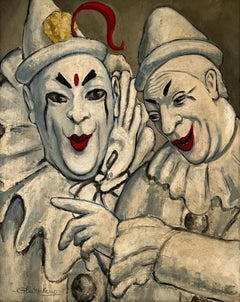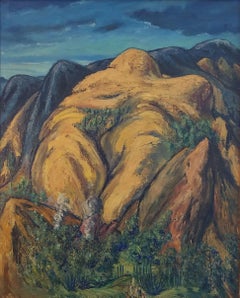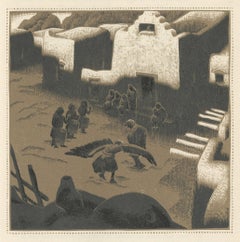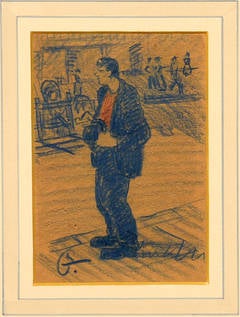Hendrik Glintenkamp Art
American, 1887-1946
The painter and illustrator Henry Glintenkamp (1887-1946) is known mainly for his anti-war illustrations that appeared in The Masses and other publications in the early twentieth century. As a painter, he was additionally successful, particularly in his landscape and urban scenes. Born in Augusta, New Jersey, the son of Hendrik and Sophie Dietz Glintenkamp, Henry received his elementary art training at the National Academy of Design (1903-06) before his study with Robert Henri the two years following.
Henri consequently attracted artists like Glintenkamp interested in returning to a sense of human qualities. Setting up his studio in the Lincoln Arcade Building with Stuart Davis and Glenn O. Coleman, Glintenkamp did work that reflects a preoccupation with urban scenes and landscapes.
In May of 1910 Glintenkamp exhibited his works as a student at the Henri School and at the Exhibition of Independent Artists of 1910. Two years later, he accepted the position of instructor at the Hoboken Arts Club in New Jersey and in 1913, he took up with others in the organization of The Masses, designed as a publication devoted to humanitarian causes. This publication stood in stark opposition to war, as its articles and cartoons reflected pacifism. At the Armory Show (1913), Glintenkamp exhibited The Village Cemetery. In 1917, Glintenkamp moved to Mexico to avoid the draft, and remained there until 1924, supporting "the socialist agenda of Mexico's new leadership."
The period following 1917 marks a new phase in the artist's development. Brighter in color and compositionally more involved, his later works are more discordant than the artist's earlier work. The artist sacrificed the atmospheric quality of the limited palette for the increased influence of modernist movements. After extensive travels in Europe, Glintenkamp returned to New York in 1934, and became a teacher at the New York School of Fine and Industrial Art and the John Reed Club School of Art. As chairman for the committee responsible for the organization of an Exhibition in Defense of World Democracy, in 1937, Glintenkamp continued his humanitarian purpose, though never really took up with the socialist rebels, many of whom followed similar groups and publications. Indeed, Glintenkamp was instrumental in founding the American Artists' Congress; he continued serving its needs as both the organization's president and secretary. A peripheral member of the impressionist-tonalist group in his early career, Glintenkamp had progressed through many American movements by the time of his death in 1946.(Biography provided by Helicline Fine Art)
to
3
2
2
1
1
1
1
Overall Height
to
Overall Width
to
2
2
2
1
1
1
1
1
1
1
1
3
1
2
3
6,958
3,331
2,514
1,213
2
2
1
1
1
Artist: Hendrik Glintenkamp
"Clowns: Aren't We All?" Henry Glintenkamp, WPA Era Circus Figures, Modern
By Hendrik Glintenkamp
Located in New York, NY
Hendrik (Henry) J Glintenkamp
Clowns: Aren't We All?, 1942
Signed lower left; signed, titled and dated on the reverse
Oil on Masonite
20 x 16 inches
The painter and illustrator Henr...
Category
1940s American Realist Hendrik Glintenkamp Art
Materials
Masonite, Oil
"Mexican Mountains, " Hendrik Glintenkamp, Modernist Landscape
By Hendrik Glintenkamp
Located in New York, NY
Hendrik (Henry) J Glintenkamp (1887 - 1946)
Mexican Mountains, 1940
Oil on canvas
32 x 26 inches
Signed lower left; signed and dated on the reverse
T...
Category
1940s American Modern Hendrik Glintenkamp Art
Materials
Oil, Canvas
Hendrik Glintenkamp, (Farmyard)
By Hendrik Glintenkamp
Located in New York, NY
More a wood engraving rather than a woodcut, Glintenkamp's Farmyard scene was given all the care and detail of the artist's more complex images. It is signed and numbered in pencil. ...
Category
1920s American Modern Hendrik Glintenkamp Art
Materials
Woodcut
Related Items
Young girl Redhead Holding her father's hand Illustration
By Robert Riggs
Located in Miami, FL
There is a reason why there are few contemporary painters who can paint a portrait this good. It's hard to do. It's easy to throw some paint or spray a mess of graffiti on canvas. ...
Category
1940s American Realist Hendrik Glintenkamp Art
Materials
Oil
H 16 in W 16 in D 1 in
An Eagle Ceremony at Tesuque Pueblo
By Gustave Baumann
Located in Fairlawn, OH
An Eagle Ceremony at Tesuque Pueblo
Woodcut printed in two colors, 1932
Unsigned as usual; initialed in the plate lower left (see photo)
As published by Elmer Adler in "The Colophon:...
Category
1930s American Modern Hendrik Glintenkamp Art
Materials
Woodcut
Untitled (Farm in Winter)
By Julius M. Delbos
Located in Los Angeles, CA
This work is part of our exhibition America Coast to Coast: Artists of the 1940s
Untitled (Farm in Winter), 1940s, oil on canvas, signed lower right, 26 x 30 inches, presented in an original frame
Julius Delbos...
Category
1940s American Modern Hendrik Glintenkamp Art
Materials
Canvas, Oil
Colliers Magazine 1947 American Scene Social Realism Modern Families in the Snow
Located in New York, NY
Colliers Magazine 1947 American Scene Social Realism Modern Families in the Snow
Katherine Wiggins (American 20th Century)
"The Shrimp"
20 x 24 inches
Egg tempera on masonite. c. 1...
Category
1940s American Realist Hendrik Glintenkamp Art
Materials
Egg Tempera, Masonite
Landscape
By Marcel Emile Cailliet
Located in Los Angeles, CA
Landscape, 1940, oil on canvas, 24 x 20 inches, signed, dated and titled verso: “Marcel Cailliet ’40 – S.C.” and “Marcel Cailliet Landscape”; likely exhibited at the annual juried st...
Category
1940s American Modern Hendrik Glintenkamp Art
Materials
Canvas, Oil
Ventian Courtyard
By Enid Smiley
Located in Buffalo, NY
An original oil on canvas by listed New York female artist Enid Smiley.
Category
1950s American Modern Hendrik Glintenkamp Art
Materials
Oil, Canvas
Six O'Clock
Located in Los Angeles, CA
Six O-Clock, c. 1942, oil on canvas, 30 x 20 inches, signed and titled several times verso of frame and stretcher (perhaps by another hand), marked “Rehn” several times on frame (for the Frank K. M. Rehn Galleries in New York City, who represented Craig at the time); Exhibited: 1) 18th Biennial Exhibition of Contemporary American Oil Paintings from March 21 to May 2, 1943 at The Corcoran Gallery of Art in Washington, D.C. #87, original price $450 (per catalog) (exhibition label verso), 2) Craig’s one-man show at the Frank K. M. Rehn Galleries, New York City, from October 26 to November 14, 1942, #10 (original price listed as $350); and 3) Exhibition of thirty paintings sponsored by the Harrisburg Art Association at the State Museum of Pennsylvania in Harrisburg in March, 1944 (concerning this exhibit, Penelope Redd of The Evening News (Harrisburg, Pennsylvania) wrote: “Other paintings that have overtones of superrealism inherent in the subjects include Tom Craig’s California nocturne, ‘Six O’Clock,’ two figures moving through the twilight . . . .” March 6, 1944, p. 13); another label verso from The Museum of Art of Toledo (Ohio): original frame: Provenance includes George Stern Gallery, Los Angeles, CA
About the Painting
Long before Chris Burden’s iconic installation outside of the Los Angeles County Museum of Art, Urban Light, another artist, Tom Craig, made Southern California streetlights the subject of one of his early 1940s paintings. Consisting of dozens of recycled streetlights from the 1920s and 1930s forming a classical colonnade at the museum’s entrance, Burden’s Urban Light has become a symbol of Los Angeles. For Burden, the streetlights represent what constitutes an advanced society, something “safe after dark and beautiful to behold.” It seems that Craig is playing on the same theme in Six O-Clock. Although we see two hunched figures trudging along the sidewalk at the end of a long day, the real stars of this painting are the streetlights which brighten the twilight and silhouette another iconic symbol of Los Angeles, the palm trees in the distance. Mountains in the background and the distant view of a suburban neighborhood join the streetlights and palm trees as classic subject matter for a California Scene painting, but Craig gives us a twist by depicting the scene not as a sun-drenched natural expanse. Rather, Craig uses thin layers of oil paint, mimicking the watercolor technique for which he is most famous, to show us the twinkling beauty of manmade light and the safety it affords. Although Southern California is a land of natural wonders, the interventions of humanity are already everywhere in Los Angeles and as one critic noted, the resulting painting has an air of “superrealism.”
About the Artist
Thomas Theodore Craig was a well-known fixture in the Southern California art scene. He was born in Upland California. Craig graduated with a degree in botany from Pomona College and studied painting at Pamona and the Chouinard Art School with Stanton MacDonald-Wright and Barse Miller among others. He became close friends with fellow artist Milford Zornes...
Category
1940s American Modern Hendrik Glintenkamp Art
Materials
Canvas, Oil
Modernist American Landscape Painting 1950 Mountain Shadow Rare Framed Tranquil
By Francis Kelly
Located in Buffalo, NY
Wonderful modernist landscape painting.
Francis Kelly was born in 1927 in St. Paul, Minnesota. He received his early education in Chicago and California. He served in the United States Navy from 1944 to 1948 when he entered the Art Center School, Los Angeles. During 1951 in 1952 he lived in Paris, attending the Academie de la Grande, Chaumiere. In 1953 he went to the University of Hawaii, Honolulu, and then to the University of California at Los Angeles, where he was graphic laboratory assistant to John Paul Jones.
Awarded a Fulbright Grant in 1955 he came to the Graphic Department of the Central School, London. The St. George's Gallery first introduced his etchings in Britain. In 1958 Kelly was awarded the Stacy Grant for painting. His work has been shown at Royal Academy Exhibitions and he has traveled extensively.
In 1966 he was appointed Art organizer for the U.S. Embassy "Festival of Arts in Humanities". His paintings were shown in the exhibition "Five American Artists in Britain". During 1976 he acted in a similar capacity on behalf of Windsor & Newton Ltd., who sponsored an exhibition of American artists commemorating the U.S. Bicentennial. He appeared in the film Science in Art.
Kelly has studied painting conservation at the Courtald Institute. In 1967 he was sent to the Italian Art and Archives Rescue Fund to Florence to restore flood damaged paintings. In 1971 his book, Art Restoration, was published by David and Charles and in the U.S. by McGraw-Hill. His second book, The Studio and The Artist was published in 1975.
Kelly's work has been shown at 24 museums in Great Britain and numerous galleries. Acquisitions have been made by many public and private collections, universities and educational services.
During more than 40 years in Britain he has found a growing affinity with the countryside, observing less the well-known landmarks but rather more the timeless rural lanes and by-ways as yet still unspoiled by building and industry. A member of the group in Brighton preserving Brighton's West Pier, he has produced a series of works recording the ravages of time on this finest of Victorian structures.
Category
1950s American Modern Hendrik Glintenkamp Art
Materials
Oil, Canvas
Antique American Oil Painting Portrait Young Woman Necklace Period Frame Rare
Located in Buffalo, NY
A beautiful and rare antique American portrait of a young woman in a stunning period frame, likely original to the piece.
Unsigned but beaut...
Category
1890s American Realist Hendrik Glintenkamp Art
Materials
Oil, Canvas
Untitled (Collapsed Shacks)
By Karl Fortress
Located in Los Angeles, CA
Untitled (Collapsed Shacks), c. 1940s, oil on canvas, signed lower left, 20 ½ x 26 ½ inches, presented in a period frame
This work is part of our exhibition America Coast to Coast: ...
Category
1940s American Modern Hendrik Glintenkamp Art
Materials
Canvas, Oil
'Hill' — 1930s American Modernism
By Paul Landacre
Located in Myrtle Beach, SC
Paul Landacre, 'Hill', wood engraving, 1936, edition 60 (only 54 printed); only 2 impressions printed in a second edition of 150. Signed, titled, and numbered '49/60' in pencil. Wien...
Category
1930s American Modern Hendrik Glintenkamp Art
Materials
Woodcut
Genre Scene Music Party Among Friends 1911 Oil Painting on Canvas Signed
Located in Stockholm, SE
Light and briefly executed genre scene depicts cozy domestic atmosphere with few people singing and playing guitars surrounded by listeners. All inhabitants of the moment are greatly...
Category
Early 20th Century American Realist Hendrik Glintenkamp Art
Materials
Canvas, Wood, Oil
Previously Available Items
"Cactus, Tulips, and Tangerines Still Life, " Hendrik Glintenkamp, Mexico Modern
By Hendrik Glintenkamp
Located in New York, NY
Hendrik (Henry) J Glintenkamp (1887 - 1946)
Cactus, Tulips, and Tangerines Still Life, 1928
Oil on board
26 x 20 inches
Signed upper right; signed, dated and titled on the reverse
T...
Category
1920s Hendrik Glintenkamp Art
Materials
Board, Oil
Streets of New York
By Hendrik Glintenkamp
Located in Wiscasset, ME
Born in 1887 in Augusta, New Jersey, painter, printmaker, illustrator and sculptor Hendrik Glintenkamp studied at the National Academy of Design and with Robert Henri and John Sloan ...
Category
1910s Ashcan School Hendrik Glintenkamp Art
Materials
Crayon
Hendrik Glintenkamp art for sale on 1stDibs.
Find a wide variety of authentic Hendrik Glintenkamp art available for sale on 1stDibs. You can also browse by medium to find art by Hendrik Glintenkamp in oil paint, paint, board and more. Much of the original work by this artist or collective was created during the 20th century and is mostly associated with the modern style. Not every interior allows for large Hendrik Glintenkamp art, so small editions measuring 6 inches across are available. Customers who are interested in this artist might also find the work of August Mosca, Luigi Lucioni, and Frank Weston Benson. Hendrik Glintenkamp art prices can differ depending upon medium, time period and other attributes. On 1stDibs, the price for these items starts at $400 and tops out at $9,750, while the average work can sell for $6,500.






